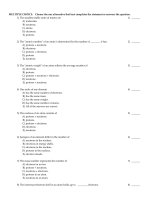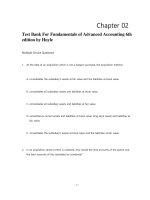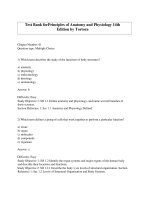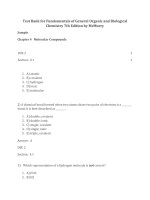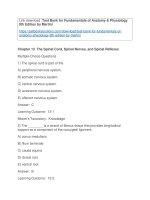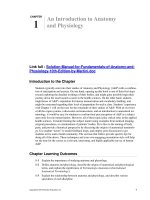Test bank for fundamentals of anatomy and physiology 11e c14
Bạn đang xem bản rút gọn của tài liệu. Xem và tải ngay bản đầy đủ của tài liệu tại đây (722.48 KB, 44 trang )
Chapterȱ14 TheȱBrainȱandȱCranialȱNerves
Multiple Choice Questions
1) Theȱadultȱhumanȱbrainȱcontainsȱalmostȱ________ȱofȱtheȱbodyȇsȱneuralȱtissue.
A) 15ȱpercent
B) 25ȱpercent
C) 68ȱpercent
D) 97ȱpercent
E) 35ȱpercent
Answer: D
LearningȱOutcome: 14-1
BloomȇsȱTaxonomy: Remembering
2) Maleȱbrainsȱareȱtypicallyȱ________ȱcomparedȱtoȱfemaleȱbrains.
A) larger
B) smaller
C) theȱsameȱsize
D) veryȱsmooth
E) moreȱconvoluted
Answer: A
LearningȱOutcome: 14-1
BloomȇsȱTaxonomy: Remembering
3) Duringȱembryonicȱdevelopment,ȱwhichȱofȱtheȱfollowingȱsecondaryȱbrainȱvesiclesȱwillȱformȱthe
cerebrum?
A) telencephalon
B) diencephalon
C) mesencephalon
D) metencephalon
E) myelencephalon
Answer: A
LearningȱOutcome: 14-1
BloomȇsȱTaxonomy: Remembering
4) Whichȱofȱtheseȱisȱnotȱoneȱofȱtheȱmainȱdivisionsȱofȱtheȱadultȱbrain?
A) cerebrum
B) diencephalon
C) prosencephalon
D) brainstem
E) cerebellum
Answer: C
LearningȱOutcome: 14-1
BloomȇsȱTaxonomy: Remembering
Copyrightȱ©ȱ2018ȱPearsonȱEducation,ȱInc.
430ȱȱȱTestȱBankȱforȱFundamentalsȱofȱAnatomyȱ&ȱPhysiology,ȱ11e
5) Whichȱofȱtheȱfollowingȱliesȱbetweenȱtheȱcerebrumȱandȱtheȱbrainȱstem?
A) medullaȱoblongata
B) pons
C) mesencephalon
D) diencephalon
E) cerebellum
Answer: D
LearningȱOutcome: 14-1
BloomȇsȱTaxonomy: Remembering
6) Theȱfloorȱofȱtheȱdiencephalonȱisȱformedȱbyȱthe
A) hypothalamus.
B) thalamus.
C) brainȱstem.
D) mesencephalon.
E) pons.
Answer: A
LearningȱOutcome: 14-1
BloomȇsȱTaxonomy: Remembering
7) Theȱtractsȱthatȱconnectȱtheȱcerebellumȱtoȱtheȱbrainȱstemȱareȱlocatedȱinȱthe
A) medullaȱoblongata.
B) pons.
C) mesencephalon.
D) diencephalon.
E) thalamus.
Answer: B
LearningȱOutcome: 14-1
BloomȇsȱTaxonomy: Remembering
8) Autonomicȱcentersȱthatȱcontrolȱbloodȱpressure,ȱheartȱrate,ȱandȱdigestionȱareȱlocatedȱinȱthe
A) medullaȱoblongata.
B) pons.
C) midbrain.
D) diencephalon.
E) cerebellum.
Answer: A
LearningȱOutcome: 14-1
BloomȇsȱTaxonomy: Remembering
9) Theȱcerebellumȱandȱponsȱdevelopȱfromȱthe
A) telencephalon.
B) diencephalon.
C) mesencephalon.
D) metencephalon.
E) myelencephalon.
Answer: D
LearningȱOutcome: 14-1
BloomȇsȱTaxonomy: Remembering
Copyrightȱ©ȱ2018ȱPearsonȱEducation,ȱInc.
Chapterȱ14ȱȱTheȱBrainȱandȱCranialȱNervesȱȱȱ 431
10) Sensoryȱinformationȱisȱprocessedȱandȱrelayedȱtoȱtheȱcerebrumȱbyȱthe
A) medullaȱoblongata.
B) pons.
C) midbrain.
D) thalamus.
E) cerebellum.
Answer: D
LearningȱOutcome: 14-1
BloomȇsȱTaxonomy: Remembering
11) Asȱyouȱascendȱfromȱtheȱmedullaȱoblongataȱtoȱtheȱcerebrum,ȱtheȱfunctionsȱofȱeachȱsuccessive
levelȱbecome
A) moreȱcomplex.
B) simpler.
C) betterȱunderstood.
D) moreȱcrucialȱtoȱvisceralȱfunctions.
E) criticalȱtoȱreflexes.
Answer: A
LearningȱOutcome: 14-1
BloomȇsȱTaxonomy: Understanding
12) Theȱ________ȱprovidesȱtheȱprincipalȱlinkȱbetweenȱtheȱnervousȱandȱendocrineȱsystems.
A) cerebellum
B) medullaȱoblongata
C) cerebrum
D) pons
E) hypothalamus
Answer: E
LearningȱOutcome: 14-1
BloomȇsȱTaxonomy: Remembering
13) Theȱventricleȱassociatedȱwithȱtheȱponsȱandȱupperȱmedullaȱisȱthe
A) first.
B) second.
C) third.
D) fourth.
E) lateral.
Answer: D
LearningȱOutcome: 14-1
BloomȇsȱTaxonomy: Remembering
14) Whichȱofȱtheȱfollowingȱisȱtrue aboutȱtheȱcerebralȱcortex?
A) Itȱisȱaȱdeepȱlayerȱofȱgrayȱmatter.
B) Itȱisȱaȱsuperficialȱlayerȱofȱgrayȱmatter.
C) Itȱisȱaȱdeepȱlayerȱofȱwhiteȱmatter.
D) Itȱisȱaȱsuperficialȱlayerȱofȱwhiteȱmatter.
E) Itȱisȱaȱdeepȱlayerȱofȱbothȱwhiteȱandȱgrayȱmatter.
Answer: B
LearningȱOutcome: 14-1
BloomȇsȱTaxonomy: Remembering
Copyrightȱ©ȱ2018ȱPearsonȱEducation,ȱInc.
432ȱȱȱTestȱBankȱforȱFundamentalsȱofȱAnatomyȱ&ȱPhysiology,ȱ11e
15) Whenȱyouȱperformȱaȱphysicalȱactivityȱthatȱyouȱhaveȱnotȱdoneȱinȱaȱwhile,ȱsuchȱasȱridingȱaȱbike,
whichȱareaȱofȱyourȱbrainȱcoordinatesȱyourȱmovementsȱwithȱlearnedȱexperiences?
A) thalamus
B) pons
C) midbrain
D) cerebellum
E) medullaȱoblongata
Answer: D
LearningȱOutcome: 14-1
BloomȇsȱTaxonomy: Understanding
16) Duringȱdevelopment,ȱthreeȱprimaryȱbrainȱvesiclesȱform.ȱTheȱthreeȱvesiclesȱareȱthe
A) prosencephalon,ȱmesencephalon,ȱandȱrhombencephalon.
B) telencephalon,ȱdiencephalon,ȱandȱmesencephalon.
C) mesencephalon,ȱmetencephalon,ȱandȱmyelencephalon.
D) cerebrum,ȱdiencephalon,ȱandȱmidbrain.
E) rhombencephalon,ȱdiencephalon,ȱandȱtelencephalon.
Answer: A
LearningȱOutcome: 14-1
BloomȇsȱTaxonomy: Remembering
17) Theȱlateralȱventriclesȱareȱfound
A) inȱtheȱcerebellarȱhemispheres.
B) betweenȱtheȱponsȱandȱtheȱmidbrain.
C) inȱtheȱcerebralȱhemispheres.
D) inȱtheȱdiencephalon.
E) inȱtheȱspinalȱcord.
Answer: C
LearningȱOutcome: 14-1
BloomȇsȱTaxonomy: Remembering
18) Theȱmedullaȱoblongata,ȱpons,ȱandȱmidbrainȱcompriseȱthe
A) basalȱganglia.
B) brainȱstem.
C) mesencephalon.
D) ventricles.
E) diencephalon.
Answer: B
LearningȱOutcome: 14-1
BloomȇsȱTaxonomy: Remembering
19) Theȱroundedȱelevationsȱofȱtheȱcerebrumȱthatȱincreaseȱitsȱsurfaceȱareaȱareȱcalled
A) sulci.
B) fissures.
C) corticalȱfolds.
D) gyri.
E) duralȱsinuses.
Answer: D
LearningȱOutcome: 14-1
BloomȇsȱTaxonomy: Remembering
Copyrightȱ©ȱ2018ȱPearsonȱEducation,ȱInc.
Chapterȱ14ȱȱTheȱBrainȱandȱCranialȱNervesȱȱȱ 433
20) Theȱwallȱbetweenȱtheȱlateralȱventriclesȱisȱcalledȱthe
A) cerebralȱaqueduct.
B) fornix.
C) falxȱcerebri.
D) corpusȱcallosum.
E) septumȱpellucidum.
Answer: E
LearningȱOutcome: 14-1
BloomȇsȱTaxonomy: Remembering
21) Theȱpassagewayȱbetweenȱtheȱlateralȱventriclesȱandȱtheȱthirdȱventricleȱisȱthe
A) posteriorȱforamen.
B) interventricularȱforamen.
C) cerebralȱaqueduct.
D) lateralȱforamen.
E) centralȱcanal.
Answer: B
LearningȱOutcome: 14-1
BloomȇsȱTaxonomy: Remembering
22) Specializedȱ________ȱformȱtheȱsecretoryȱcomponentȱofȱtheȱchoroidȱplexus.
A) epididymalȱcells
B) ependymalȱcells
C) arachnoidȱcells
D) astrocyte
E) bloodȱcells
Answer: B
LearningȱOutcome: 14-2
BloomȇsȱTaxonomy: Remembering
23) Theȱduralȱvenousȱsinusesȱareȱlocatedȱinȱthe
A) paranasalȱcavity.
B) arachnoidȱfolds.
C) piaȱmater.
D) duralȱfolds.
E) tentoriumȱcerebelli.
Answer: D
LearningȱOutcome: 14-2
BloomȇsȱTaxonomy: Remembering
24) Whatȱstructureȱisȱcoveredȱbyȱmanyȱbloodȱvesselsȱandȱadheresȱtightlyȱtoȱtheȱsurfaceȱofȱthe
brain?
A) piaȱmater
B) arachnoidȱmater
C) duraȱmater
D) cranialȱplexus
E) choroidȱplexus
Answer: A
LearningȱOutcome: 14-2
BloomȇsȱTaxonomy: Remembering
Copyrightȱ©ȱ2018ȱPearsonȱEducation,ȱInc.
434ȱȱȱTestȱBankȱforȱFundamentalsȱofȱAnatomyȱ&ȱPhysiology,ȱ11e
25) Theȱbrainȱrequiresȱaȱsubstantialȱbloodȱsupply.ȱTheȱvesselsȱthatȱdeliverȱbloodȱtoȱtheȱbrainȱare
the
A) externalȱcarotidȱarteries.
B) facialȱarteries.
C) jugularȱveins.
D) internalȱcarotidȱandȱvertebralȱarteries.
E) duralȱsinuses.
Answer: D
LearningȱOutcome: 14-2
BloomȇsȱTaxonomy: Remembering
26) Whichȱofȱtheȱfollowingȱisȱnotȱaȱpropertyȱofȱtheȱblood-brainȱbarrier?
A) Theȱcapillaryȱendothelialȱcellsȱareȱinterconnectedȱbyȱtightȱjunctions.
B) Itȱisȱveryȱpermeableȱtoȱmanyȱwaterȱandȱlipid -solubleȱcompounds.
C) AstrocytesȱsurroundȱtheȱCNSȱcapillaries.
D) Itȱisȱabsentȱinȱportionsȱofȱtheȱhypothalamus.
E) Itȱisȱintactȱexceptȱinȱareasȱknownȱasȱcircumventricularȱorgans.
Answer: B
LearningȱOutcome: 14-2
BloomȇsȱTaxonomy: Understanding
27) Theȱduralȱfoldȱthatȱprojectsȱintoȱtheȱlongitudinalȱfissureȱbetweenȱcerebralȱhemispheresȱis
calledȱthe
A) duralȱsinus.
B) falxȱcerebri.
C) tentoriumȱcerebelli.
D) falxȱcerebelli.
E) choroidȱplexus.
Answer: B
LearningȱOutcome: 14-2
BloomȇsȱTaxonomy: Remembering
28) Cerebrospinalȱfluid
A) isȱsecretedȱbyȱependymalȱcells.
B) isȱformedȱbyȱaȱpassiveȱprocess.
C) isȱnormallyȱproducedȱtwiceȱasȱfastȱasȱitȱisȱremoved.
D) hasȱalmostȱtheȱsameȱcompositionȱasȱbloodȱplasma.
E) containsȱbloodȱcellsȱandȱbloodȱplasma.
Answer: A
LearningȱOutcome: 14-2
BloomȇsȱTaxonomy: Understanding
Copyrightȱ©ȱ2018ȱPearsonȱEducation,ȱInc.
Chapterȱ14ȱȱTheȱBrainȱandȱCranialȱNervesȱȱȱ 435
29) Whichȱstatementȱisȱtrueȱregardingȱtheȱmeningesȱandȱcerebrospinalȱfluidȱofȱtheȱspinalȱcordȱand
brain?
A) Spinalȱfluidȱisȱsecretedȱbothȱinȱtheȱbrainȱandȱinȱtheȱspinalȱcordȱareas.
B) Thereȱisȱanȱepiduralȱspaceȱassociatedȱwithȱtheȱspinalȱmeninges,ȱbutȱnotȱwithȱtheȱcranial
meninges.
C) Theȱmeningesȱaroundȱtheȱbrainȱareȱnotȱtheȱsameȱasȱthoseȱaroundȱtheȱspinalȱcord.
D) Thereȱisȱaȱsubarachnoidȱspaceȱwithinȱtheȱspinalȱmeningesȱbutȱnotȱtheȱcranialȱmeninges.
E) Theȱchoroidȱplexusesȱareȱlocatedȱonlyȱwithinȱtheȱbrain,ȱnotȱwithinȱtheȱspinalȱcord.
Answer: E
LearningȱOutcome: 14-2
BloomȇsȱTaxonomy: Applying
30) Theȱchoroidȱplexusȱisȱcomposedȱof
A) lymphaticȱvessels.
B) bloodȱvessels.
C) nerveȱfibers.
D) ganglia.
E) subarachnoidȱgranulations.
Answer: B
LearningȱOutcome: 14-2
BloomȇsȱTaxonomy: Remembering
31) Cerebrospinalȱfluidȱentersȱtheȱbloodȱcirculationȱatȱthe
A) jugularȱveins.
B) centralȱcanal.
C) arachnoidȱgranulations.
D) tentoriumȱcerebelli.
E) frontalȱsinus.
Answer: C
LearningȱOutcome: 14-2
BloomȇsȱTaxonomy: Remembering
32) Whatȱcontainsȱaȱspiderȱweb-likeȱnetworkȱofȱcellsȱandȱfibersȱthroughȱwhichȱcerebrospinalȱfluid
flows?
A) subduralȱspace
B) duralȱsinus
C) falxȱcerebri
D) subarachnoidȱspace
E) piaȱmater
Answer: D
LearningȱOutcome: 14-2
BloomȇsȱTaxonomy: Remembering
Copyrightȱ©ȱ2018ȱPearsonȱEducation,ȱInc.
436ȱȱȱTestȱBankȱforȱFundamentalsȱofȱAnatomyȱ&ȱPhysiology,ȱ11e
33) Whichȱofȱtheȱfollowingȱisȱnotȱaȱfunctionȱofȱcerebrospinalȱfluid?
A) providesȱcushioningȱforȱdelicateȱneuralȱtissues
B) providesȱbuoyantȱsupportȱforȱtheȱbrain
C) actsȱasȱaȱtransportȱmediumȱforȱnutrients
D) producesȱATPȱforȱimpulseȱtransmission
E) actsȱasȱaȱtransportȱmediumȱforȱwasteȱproducts
Answer: D
LearningȱOutcome: 14-2
BloomȇsȱTaxonomy: Remembering
34) Whichȱstatementȱisȱtrueȱregardingȱcerebrospinalȱfluid?
A) CSFȱisȱidenticalȱinȱcompositionȱtoȱbloodȱplasma.
B) CSFȱisȱmadeȱduringȱfetalȱdevelopmentȱandȱdoesȱnotȱchangeȱthroughȱtheȱlifetimeȱofȱthe
person.
C) ThereȱisȱaboutȱaȱliterȱofȱCSFȱwithinȱtheȱbrainȱandȱspinalȱcord.
D) IfȱCSFȱisȱnotȱproperlyȱresorbed,ȱtheȱresultȱwouldȱbeȱhydrocephalus.
E) CSFȱmovesȱbackȱintoȱtheȱbloodȱsupplyȱbyȱtheȱprocessȱofȱosmosis.
Answer: D
LearningȱOutcome: 14-2
BloomȇsȱTaxonomy: Understanding
35) Hydrocephalus,ȱorȱȈwaterȱonȱtheȱbrain,Ȉȱmayȱresultȱfrom
A) deficientȱproductionȱofȱcerebrospinalȱfluid.
B) excessiveȱproductionȱofȱcerebrospinalȱfluid.
C) blockageȱofȱcirculationȱofȱCSF.
D) excessiveȱwaterȱintake.
E) blockageȱofȱCSFȱcirculationȱorȱexcessiveȱCSFȱproduction.
Answer: E
LearningȱOutcome: 14-2
BloomȇsȱTaxonomy: Understanding
36) ToȱreturnȱCSFȱtoȱcirculation,ȱarachnoidȱgranulationsȱextendȱintoȱthe
A) subarachnoidȱspace.
B) superiorȱsagittalȱsinus.
C) carotidȱcanal.
D) inferiorȱsagittalȱsinus.
E) jugularȱforamen.
Answer: B
LearningȱOutcome: 14-2
BloomȇsȱTaxonomy: Remembering
Copyrightȱ©ȱ2018ȱPearsonȱEducation,ȱInc.
Chapterȱ14ȱȱTheȱBrainȱandȱCranialȱNervesȱȱȱ 437
37) Inȱeachȱventricleȱisȱaȱbloodȱvesselȱnetworkȱcalledȱtheȱ________ȱthatȱproducesȱcerebrospinal
fluid.
A) choroidȱplexus
B) jugularȱvein
C) carotidȱartery
D) vertebralȱartery
E) duralȱsinus
Answer: A
LearningȱOutcome: 14-2
BloomȇsȱTaxonomy: Remembering
38) Chambersȱwithinȱtheȱbrainȱthatȱcontainȱcerebrospinalȱfluidȱareȱcalled
A) plexuses.
B) ganglia.
C) sinuses.
D) aqueducts.
E) ventricles.
Answer: E
LearningȱOutcome: 14-2
BloomȇsȱTaxonomy: Remembering
39) Twoȱlargeȱvenousȱsinuses,ȱtheȱsagittalȱsinuses,ȱlieȱwithinȱaȱduralȱfoldȱcalledȱthe
A) cerebralȱaqueduct.
B) basalȱganglia.
C) falxȱcerebri.
D) tentoriumȱcerebelli.
E) septumȱpellucidum.
Answer: C
LearningȱOutcome: 14-2
BloomȇsȱTaxonomy: Remembering
40) Theȱduralȱsinusesȱformȱbetweenȱwhichȱtwoȱlayersȱofȱtheȱcranialȱduraȱmater?
A) piaȱandȱarachnoidȱlayers
B) periostealȱandȱendostealȱlayers
C) meningealȱandȱcranialȱlayers
D) periostealȱandȱmeningealȱlayers
E) superiorȱandȱinferiorȱsagittalȱlayers
Answer: D
LearningȱOutcome: 14-2
BloomȇsȱTaxonomy: Remembering
Copyrightȱ©ȱ2018ȱPearsonȱEducation,ȱInc.
438ȱȱȱTestȱBankȱforȱFundamentalsȱofȱAnatomyȱ&ȱPhysiology,ȱ11e
41) Tonyȱhitȱhisȱheadȱinȱaȱcarȱaccident.ȱTheȱphysiciansȱdiagnosedȱhimȱwithȱaȱsubdural
hemorrhage.ȱWhichȱofȱtheȱfollowingȱcorrectlyȱstatesȱwhereȱtheȱbleedingȱhasȱoccurredȱinȱhis
brain?
A) Bloodȱisȱbetweenȱtheȱduraȱmaterȱandȱtheȱskull.
B) Bloodȱisȱbetweenȱtheȱpiaȱmaterȱandȱarachnoidȱmater.
C) Bloodȱisȱbetweenȱtheȱpiaȱmaterȱandȱtheȱbrain.
D) Bloodȱisȱbetweenȱtheȱsuperiorȱsagittalȱsinusȱandȱinferiorȱsagittalȱsinus.
E) Bloodȱisȱbetweenȱtheȱduraȱmaterȱandȱtheȱarachnoidȱmater.
Answer: E
LearningȱOutcome: 14-2
BloomȇsȱTaxonomy: Understanding
42) HowȱrapidlyȱisȱtheȱCSFȱvolumeȱreplaced?
A) everyȱ20ȱminutes
B) everyȱ2ȱhours
C) everyȱ8ȱhours
D) everyȱ2ȱdays
E) everyȱweek
Answer: C
LearningȱOutcome: 14-2
BloomȇsȱTaxonomy: Remembering
43) Whichȱduralȱfoldȱseparatesȱtheȱcerebralȱhemispheresȱfromȱtheȱcerebellum?
A) tentoriumȱcerebelli
B) falxȱcerebelli
C) falxȱcerebri
D) longitudinalȱfissure
E) superiorȱsagittalȱsinus
Answer: A
LearningȱOutcome: 14-2
BloomȇsȱTaxonomy: Remembering
44) Aȱpatientȱcomesȱintoȱtheȱemergencyȱroomȱwithȱweaknessȱonȱoneȱsideȱandȱdifficultyȱwalking
andȱtalking.ȱYouȱdetermineȱthatȱtheȱbrainȱhasȱbeenȱdeprivedȱofȱoxygenȱdueȱtoȱlackȱofȱregional
bloodȱflow.ȱYouȱsuspectȱthatȱpatientȱhasȱmostȱlikelyȱexperienced
A) aȱsubduralȱhemorrhage.
B) meningitis.
C) hydrocephalus.
D) cranialȱtrauma.
E) aȱcerebrovascularȱaccident.
Answer: E
LearningȱOutcome: 14-2
BloomȇsȱTaxonomy: Applying
Copyrightȱ©ȱ2018ȱPearsonȱEducation,ȱInc.
Chapterȱ14ȱȱTheȱBrainȱandȱCranialȱNervesȱȱȱ 439
Figureȱ14-1ȱTheȱCirculationȱofȱCerebrospinalȱFluid
UseȱFigureȱ14-1ȱtoȱanswerȱtheȱfollowingȱquestions:
45) IdentifyȱtheȱstructureȱlabeledȱȈ1.Ȉ
A) choroidȱplexus
B) cerebralȱaqueduct
C) thirdȱventricle
D) subarachnoidȱspace
E) corpusȱcallosum
Answer: A
LearningȱOutcome: 14-2
BloomȇsȱTaxonomy: Remembering
Copyrightȱ©ȱ2018ȱPearsonȱEducation,ȱInc.
440ȱȱȱTestȱBankȱforȱFundamentalsȱofȱAnatomyȱ&ȱPhysiology,ȱ11e
46) Ependymalȱcellsȱareȱmostȱlikelyȱfoundȱatȱwhichȱstructure?
A) 10
B) 2
C) 9
D) 3
E) 7
Answer: B
LearningȱOutcome: 14-2
BloomȇsȱTaxonomy: Remembering
47) CSFȱisȱabsorbedȱintoȱtheȱvenousȱcirculationȱviaȱarachnoidȱgranulations.ȱIdentifyȱanȱarachnoid
granulation.
A) 8
B) 1
C) 10
D) 2
E) 4
Answer: A
LearningȱOutcome: 14-2
BloomȇsȱTaxonomy: Remembering
48) IdentifyȱtheȱstructureȱlabeledȱȈ3.Ȉ
A) lateralȱventricles
B) corporaȱquadrigemina
C) cerebralȱaqueduct
D) pons
E) centralȱcanal
Answer: C
LearningȱOutcome: 14-2
BloomȇsȱTaxonomy: Remembering
49) IdentifyȱtheȱstructureȱlabeledȱȈ4.Ȉ
A) cerebralȱaqueduct
B) lateralȱventricle
C) sagittalȱsinus
D) 4 thȱventricle
E) choroidȱplexus
Answer: D
LearningȱOutcome: 14-2
BloomȇsȱTaxonomy: Remembering
Copyrightȱ©ȱ2018ȱPearsonȱEducation,ȱInc.
Chapterȱ14ȱȱTheȱBrainȱandȱCranialȱNervesȱȱȱ 441
50) IdentifyȱtheȱstructureȱlabeledȱȈ6.Ȉ
A) choroidȱplexus
B) fourthȱventricle
C) lateralȱventricle
D) cerebralȱaqueduct
E) subarachnoidȱspace
Answer: E
LearningȱOutcome: 14-2
BloomȇsȱTaxonomy: Remembering
51) IdentifyȱtheȱstructureȱlabeledȱȈ7.Ȉ
A) duraȱmater
B) lateralȱventricle
C) fourthȱventricle
D) subarachnoidȱspace
E) filumȱterminale
Answer: A
LearningȱOutcome: 14-2
BloomȇsȱTaxonomy: Remembering
52) IdentifyȱtheȱstructureȱlabeledȱȈ9.Ȉ
A) duraȱmater
B) superiorȱsagittalȱsinus
C) lateralȱventricle
D) subarachnoidȱspace
E) arachnoidȱgranulation
Answer: B
LearningȱOutcome: 14-2
BloomȇsȱTaxonomy: Remembering
53) IdentifyȱtheȱstructureȱlabeledȱȈ10.Ȉ
A) arborȱvitae
B) centralȱcanal
C) corpusȱcallosum
D) pons
E) diencephalon
Answer: B
LearningȱOutcome: 14-2
BloomȇsȱTaxonomy: Remembering
54) Theȱcontrolȱofȱheartȱrateȱandȱbloodȱpressureȱisȱbasedȱinȱthe
A) cerebrum.
B) cerebellum.
C) diencephalon.
D) medullaȱoblongata.
E) thalamus.
Answer: D
LearningȱOutcome: 14-3
BloomȇsȱTaxonomy: Remembering
Copyrightȱ©ȱ2018ȱPearsonȱEducation,ȱInc.
442ȱȱȱTestȱBankȱforȱFundamentalsȱofȱAnatomyȱ&ȱPhysiology,ȱ11e
55) Theȱmedullaȱoblongataȱregulates
A) somaticȱmotorȱcontractions.
B) foodȱintake.
C) auditoryȱreflexes.
D) visionȱandȱhearing.
E) bloodȱpressureȱandȱrespiration.
Answer: E
LearningȱOutcome: 14-3
BloomȇsȱTaxonomy: Remembering
56) Thisȱstructureȱofȱtheȱmedullaȱoblongataȱrelaysȱinformationȱfromȱtheȱredȱnuclei,ȱmidbrain,ȱand
theȱcerebralȱcortexȱtoȱtheȱcerebellum.
A) inferiorȱolivaryȱcomplex
B) reticularȱformation
C) nucleusȱgracilis
D) nucleusȱcuneatus
E) solitaryȱnucleus
Answer: A
LearningȱOutcome: 14-3
BloomȇsȱTaxonomy: Remembering
57) Damageȱtoȱtheȱmedullaȱoblongataȱcanȱresultȱinȱdeathȱbecause
A) electricalȱactivityȱoriginatesȱwithinȱtheȱmedulla.
B) theȱvitalȱcentersȱforȱtheȱcontrolȱofȱbloodȱpressure,ȱheartȱrate,ȱandȱbreathingȱareȱlocated
there.
C) theȱbloodȱmightȱnotȱbeȱableȱtoȱcirculateȱproperlyȱaroundȱtheȱbrain.
D) bodyȱtemperatureȱisȱcontrolledȱbyȱtheȱmedulla.
E) digestiveȱprocessesȱareȱcontrolledȱbyȱtheȱmedulla.
Answer: B
LearningȱOutcome: 14-3
BloomȇsȱTaxonomy: Understanding
58) Cardiovascularȱcentersȱlocatedȱinȱtheȱ________ȱadjustȱtheȱheartȱrate,ȱtheȱstrengthȱofȱcardiac
contractions,ȱandȱtheȱflowȱofȱbloodȱthroughȱtheȱperipheralȱtissues.
A) pons
B) medullaȱoblongata
C) prefrontalȱcortex
D) thalamus
E) midbrain
Answer: B
LearningȱOutcome: 14-3
BloomȇsȱTaxonomy: Understanding
Copyrightȱ©ȱ2018ȱPearsonȱEducation,ȱInc.
Chapterȱ14ȱȱTheȱBrainȱandȱCranialȱNervesȱȱȱ 443
59) Theȱtermȱusedȱtoȱdescribeȱtheȱcrossingȱoverȱofȱaȱtractȱtoȱtheȱsideȱofȱtheȱnervousȱsystem
oppositeȱtoȱwhereȱtheȱaxonsȱoriginatedȱis
A) decussation.
B) contralateral.
C) ascendingȱcrossovers.
D) pyramidalȱtracts.
E) consensualȱtracts.
Answer: A
LearningȱOutcome: 14-3
BloomȇsȱTaxonomy: Remembering
60) Jane,ȱaȱ79-year-oldȱwoman,ȱhasȱbeenȱdiagnosedȱwithȱaȱtumorȱinȱtheȱbrain.ȱSheȱhasȱlostȱsome
sensoryȱandȱmotorȱfunctionsȱassociatedȱwithȱtheȱface,ȱlikeȱcontrolȱofȱfacialȱmusclesȱforȱemotion
andȱvariousȱsensoryȱfunctionsȱlikeȱtaste.ȱInȱaddition,ȱsheȱhasȱsomeȱhearingȱlossȱandȱbalance
problems.ȱTheȱlocationȱofȱtheȱtumorȱisȱlikelyȱtoȱbeȱthe
A) cerebellum.
B) cerebrum.
C) medulla.
D) thalamus.
E) pons.
Answer: E
LearningȱOutcome: 14-4
BloomȇsȱTaxonomy: Applying
61) Ifȱtheȱponsȱwasȱdamaged,ȱwhichȱofȱtheȱfollowingȱfunctionsȱwouldȱbeȱaffected?
A) breathing
B) controlȱofȱbloodȱpressure
C) coordination
D) sleepȱpatterns
E) judgment
Answer: A
LearningȱOutcome: 14-4
BloomȇsȱTaxonomy: Understanding
62) Theȱnucleiȱofȱwhichȱcranialȱnervesȱareȱassociatedȱwithȱtheȱmidbrain?
A) IȱandȱII
B) IIȱandȱIII
C) IIIȱandȱIV
D) IVȱandȱV
E) VȱandȱVI
Answer: C
LearningȱOutcome: 14-5
BloomȇsȱTaxonomy: Remembering
Copyrightȱ©ȱ2018ȱPearsonȱEducation,ȱInc.
444ȱȱȱTestȱBankȱforȱFundamentalsȱofȱAnatomyȱ&ȱPhysiology,ȱ11e
63) Descendingȱfibersȱfromȱtheȱponsȱtoȱtheȱcerebellumȱpassȱthroughȱtheseȱstructuresȱofȱthe
midbrain?
A) substantiaȱnigra
B) reticularȱformation
C) superiorȱcolliculus
D) corporaȱquadrigemina
E) cerebralȱpeduncles
Answer: E
LearningȱOutcome: 14-5
BloomȇsȱTaxonomy: Understanding
64) Theȱmedullaȱoblongataȱrelaysȱauditoryȱstimuliȱtoȱthe
A) substantiaȱnigra.
B) redȱnuclei.
C) cerebralȱpeduncles.
D) superiorȱcolliculi.
E) inferiorȱcolliculi.
Answer: E
LearningȱOutcome: 14-5
BloomȇsȱTaxonomy: Remembering
65) Theȱstructureȱofȱtheȱbrainȱthatȱcarriesȱascendingȱsensoryȱinformationȱtoȱtheȱthalamusȱisȱthe
A) midbrain.
B) cerebralȱaqueduct.
C) 4 thȱventricle.
D) basalȱganglion.
E) cerebellum.
Answer: A
LearningȱOutcome: 14-5
BloomȇsȱTaxonomy: Remembering
66) Nerveȱfiberȱbundlesȱonȱtheȱventrolateralȱsurfaceȱofȱtheȱmesencephalonȱareȱthe
A) tectum.
B) corporaȱquadrigemina.
C) cerebralȱpeduncles.
D) superiorȱcolliculi.
E) inferiorȱcolliculi.
Answer: C
LearningȱOutcome: 14-5
BloomȇsȱTaxonomy: Remembering
Copyrightȱ©ȱ2018ȱPearsonȱEducation,ȱInc.
Chapterȱ14ȱȱTheȱBrainȱandȱCranialȱNervesȱȱȱ 445
67) Theȱcorporaȱquadrigeminaȱisȱcomposedȱofȱthe
A) fourȱcerebralȱlobes.
B) superiorȱandȱinferiorȱcolliculi.
C) firstȱfourȱcranialȱnerves.
D) cranialȱnerveȱIV.
E) twoȱsuperiorȱcerebellarȱpedunclesȱandȱtheȱtwoȱinferiorȱcerebellarȱpeduncles.
Answer: B
LearningȱOutcome: 14-5
BloomȇsȱTaxonomy: Remembering
68) Theȱreflexȱmovementȱofȱtheȱheadȱtowardȱaȱloudȱnoiseȱisȱdirectedȱbyȱtheȱmesencephalon.
Whichȱnucleiȱaccomplishȱthis?
A) substantiaȱnigra
B) redȱnuclei
C) tectum
D) superiorȱcolliculi
E) inferiorȱcolliculi
Answer: E
LearningȱOutcome: 14-5
BloomȇsȱTaxonomy: Understanding
69) Damageȱtoȱtheȱcorporaȱquadrigeminaȱwouldȱinterfereȱwith
A) controlȱofȱautonomicȱfunction.
B) regulationȱofȱbodyȱtemperature.
C) visualȱandȱauditoryȱreflexȱmovementsȱofȱtheȱheadȱandȱneck.
D) consciousȱcontrolȱofȱskeletalȱmuscles.
E) controlȱofȱbreathing.
Answer: C
LearningȱOutcome: 14-5
BloomȇsȱTaxonomy: Understanding
70) Examinationȱofȱaȱtissueȱsampleȱfromȱtheȱcentralȱnervousȱsystemȱrevealsȱmanyȱdarkly
pigmentedȱcells.ȱThisȱtissueȱprobablyȱcameȱfromȱthe
A) nucleusȱgracilis.
B) nucleusȱcuneatus.
C) motorȱcortex.
D) substantiaȱnigra.
E) cerebellarȱnucleus.
Answer: D
LearningȱOutcome: 14-5
BloomȇsȱTaxonomy: Understanding
Copyrightȱ©ȱ2018ȱPearsonȱEducation,ȱInc.
446ȱȱȱTestȱBankȱforȱFundamentalsȱofȱAnatomyȱ&ȱPhysiology,ȱ11e
71) Theȱ________ȱareȱtheȱfourȱmassesȱonȱtheȱposteriorȱofȱtheȱmidbrain.
A) cerebralȱpeduncles
B) reticularȱformation
C) substantiaȱnigra
D) choroidȱplexuses
E) corporaȱquadrigemina
Answer: E
LearningȱOutcome: 14-5
BloomȇsȱTaxonomy: Remembering
72) Theȱmesencephalonȱcontainsȱtheȱheadquartersȱofȱtheȱ________,ȱaȱspecializedȱcomponentȱofȱthe
reticularȱformationȱthatȱcontrolsȱalertnessȱandȱattention.
A) falxȱcerebri
B) Wernickeȇsȱarea
C) generalȱassociationȱarea
D) reticularȱactivatingȱsystem
E) basalȱganglia
Answer: D
LearningȱOutcome: 14-5
BloomȇsȱTaxonomy: Understanding
73) Whichȱofȱtheȱfollowingȱtractsȱisȱcorrectlyȱmatched?
A) superiorȱcerebellarȱpeduncles:ȱlinkȱcerebellumȱwithȱnucleiȱinȱtheȱspinalȱcord
B) middleȱcerebellarȱpeduncles:ȱlinkȱcerebellumȱwithȱnucleiȱinȱtheȱpons
C) inferiorȱcerebellarȱpeduncles:ȱlinkȱcerebellumȱwithȱnucleiȱinȱtheȱcerebrum
D) superiorȱcerebellarȱpeduncles:ȱlinkȱcerebellumȱwithȱnucleiȱinȱtheȱmedullaȱoblongata
E) inferiorȱcerebellarȱpeduncles:ȱlinkȱcerebellumȱwithȱnucleiȱinȱtheȱmidbrain
Answer: B
LearningȱOutcome: 14-6
BloomȇsȱTaxonomy: Applying
74) Overseeingȱtheȱposturalȱmusclesȱofȱtheȱbodyȱandȱmakingȱrapidȱadjustmentsȱtoȱmaintain
balanceȱandȱequilibriumȱareȱfunctionsȱofȱthe
A) cerebrum.
B) thalamus.
C) cerebellum.
D) pons.
E) medullaȱoblongata.
Answer: C
LearningȱOutcome: 14-6
BloomȇsȱTaxonomy: Remembering
Copyrightȱ©ȱ2018ȱPearsonȱEducation,ȱInc.
Chapterȱ14ȱȱTheȱBrainȱandȱCranialȱNervesȱȱȱ 447
75) Theȱcerebellarȱhemispheresȱareȱseparatedȱbyȱaȱbandȱofȱcortexȱcalledȱthe
A) flocculonodularȱlobe.
B) arborȱvitae.
C) folia.
D) vermis.
E) pyramid.
Answer: D
LearningȱOutcome: 14-6
BloomȇsȱTaxonomy: Remembering
76) Theȱwhiteȱmatterȱofȱtheȱcerebellumȱformsȱthe
A) flocculonodularȱlobe.
B) arborȱvitae.
C) folia.
D) vermis.
E) pyramid.
Answer: B
LearningȱOutcome: 14-6
BloomȇsȱTaxonomy: Remembering
77) Theȱpresenceȱofȱmanyȱlarge,ȱhighly-branchedȱPurkinjeȱcellsȱinȱaȱsampleȱofȱbrainȱtissue
indicatesȱthatȱitȱcameȱfromȱthe
A) pons.
B) medulla.
C) cerebralȱcortex.
D) cerebellarȱcortex.
E) arborȱvitae.
Answer: D
LearningȱOutcome: 14-6
BloomȇsȱTaxonomy: Understanding
78) Theȱcerebellumȱcanȱbeȱpermanentlyȱdamagedȱbyȱstrokeȱorȱtemporarilyȱaffectedȱbyȱdrugsȱor
alcohol.ȱTheȱresultingȱdisturbanceȱinȱmotorȱcontrolȱisȱknownȱas
A) ataxia.
B) aphasia.
C) dysphagia.
D) Parkinsonȇs.
E) epilepsy.
Answer: A
LearningȱOutcome: 14-6
BloomȇsȱTaxonomy: Understanding
Copyrightȱ©ȱ2018ȱPearsonȱEducation,ȱInc.
448ȱȱȱTestȱBankȱforȱFundamentalsȱofȱAnatomyȱ&ȱPhysiology,ȱ11e
79) Theȱfoldsȱofȱtheȱsurfaceȱofȱtheȱcerebellum
A) areȱcalledȱfoliaȱandȱareȱlessȱprominentȱthanȱtheȱcerebralȱfolds.
B) formȱaȱnetworkȱofȱbloodȱvesselsȱoverȱtheȱbrain.
C) consistȱofȱaxonsȱandȱdendritesȱofȱneurons.
D) areȱbathedȱinȱspinalȱfluid.
E) areȱcalledȱsulci.
Answer: A
LearningȱOutcome: 14-6
BloomȇsȱTaxonomy: Understanding
80) Whichȱofȱtheȱfollowingȱisȱnotȱoneȱofȱtheȱthalamicȱnuclei?
A) ventralȱnuclei
B) medialȱnuclei
C) superiorȱnuclei
D) anteriorȱnuclei
E) dorsalȱnuclei
Answer: C
LearningȱOutcome: 14-7
BloomȇsȱTaxonomy: Remembering
81) Whichȱhypothalamicȱnucleusȱisȱresponsibleȱforȱregulatingȱcircadianȱrhythms?
A) suprachiasmaticȱnucleus
B) preopticȱarea
C) autonomicȱnucleus
D) paraventricularȱnucleus
E) tuberȱcinereum
Answer: A
LearningȱOutcome: 14-7
BloomȇsȱTaxonomy: Remembering
82) Theȱhypothalamusȱproducesȱwhichȱtwoȱhormones?
A) ADHȱandȱepinephrine
B) epinephrineȱandȱnorepinephrine
C) ADHȱandȱoxytocin
D) growthȱhormoneȱandȱmelatonin
E) oxytocinȱandȱmelatonin
Answer: C
LearningȱOutcome: 14-7
BloomȇsȱTaxonomy: Remembering
83) Whichȱofȱtheȱfollowingȱisȱtrue regardingȱtheȱpinealȱgland?
A) Itȱisȱpartȱofȱtheȱepithalamusȱandȱsecretesȱmelatonin.
B) Itȱisȱpartȱofȱtheȱhypothalamusȱandȱsecretesȱoxytocin.
C) Itȱisȱpartȱofȱtheȱthalamus.
D) Itȱisȱpartȱofȱtheȱlimbicȱsystem.
E) Itȱcontrolsȱheartȱrateȱandȱbloodȱpressure.
Answer: A
LearningȱOutcome: 14-7
BloomȇsȱTaxonomy: Understanding
Copyrightȱ©ȱ2018ȱPearsonȱEducation,ȱInc.
Chapterȱ14ȱȱTheȱBrainȱandȱCranialȱNervesȱȱȱ 449
84) Theȱpinealȱglandȱisȱpartȱofȱthe
A) hypothalamus.
B) diencephalon.
C) midbrain.
D) medullaȱoblongata.
E) brainstem.
Answer: B
LearningȱOutcome: 14-7
BloomȇsȱTaxonomy: Remembering
85) Whichȱofȱtheȱfollowingȱisȱnotȱfunctionȱofȱtheȱhypothalamus?
A) producesȱADH
B) secreteȱmelatonin
C) regulatesȱbodyȱtemperature
D) secretesȱoxytocin
E) controlsȱautonomicȱcenters
Answer: B
LearningȱOutcome: 14-7
BloomȇsȱTaxonomy: Remembering
86) Whichȱofȱtheȱfollowingȱis/areȱtrue ofȱtheȱepithalamus?
A) containsȱtheȱmammillaryȱbody
B) formsȱtheȱroofȱofȱtheȱdiencephalon
C) processesȱsensoryȱinformationȱandȱrelaysȱitȱtoȱtheȱcerebrum
D) formsȱtheȱcerebrum
E) createsȱtheȱlateralȱventricles
Answer: B
LearningȱOutcome: 14-7
BloomȇsȱTaxonomy: Remembering
87) Theȱanteriorȱnucleiȱofȱtheȱthalamus
A) areȱpartȱofȱtheȱlimbicȱsystem.
B) secreteȱpituitaryȱhormones.
C) secreteȱmelatonin.
D) receiveȱaxonȱcollateralsȱfromȱtheȱopticȱnerve.
E) secreteȱpituitaryȱhormonesȱandȱmelatonin.
Answer: A
LearningȱOutcome: 14-7
BloomȇsȱTaxonomy: Remembering
88) Theȱmedialȱnucleiȱofȱtheȱthalamus
A) areȱpartȱofȱtheȱlimbicȱsystem.
B) connectȱemotionalȱcentersȱinȱtheȱhypothalamusȱwithȱtheȱfrontalȱlobe.
C) produceȱtheȱhormoneȱoxytocin.
D) processȱvisualȱinformation.
E) processȱolfactoryȱinformation.
Answer: B
LearningȱOutcome: 14-7
BloomȇsȱTaxonomy: Remembering
Copyrightȱ©ȱ2018ȱPearsonȱEducation,ȱInc.
450ȱȱȱTestȱBankȱforȱFundamentalsȱofȱAnatomyȱ&ȱPhysiology,ȱ11e
89) Theȱdorsal/posteriorȱnucleiȱofȱtheȱthalamusȱincludesȱthe
A) basalȱnuclei.
B) lateralȱandȱmedialȱgeniculateȱnuclei.
C) mammillaryȱbody.
D) interthalamicȱadhesion.
E) redȱnucleus.
Answer: B
LearningȱOutcome: 14-7
BloomȇsȱTaxonomy: Remembering
90) Theȱopticȱtractsȱcarryȱvisualȱinformationȱfromȱtheȱretinaȱtoȱthe
A) pulvinarȱnuclei.
B) lateralȱgeniculateȱnuclei.
C) medialȱgeniculateȱnuclei.
D) supraopticȱnuclei.
E) paraventricularȱnuclei.
Answer: B
LearningȱOutcome: 14-7
BloomȇsȱTaxonomy: Remembering
91) Whichȱofȱtheȱfollowingȱisȱaȱfunctionȱofȱtheȱthalamus?
A) secreteȱcerebrospinalȱfluid
B) secreteȱmelatonin
C) processȱsensoryȱinformationȱandȱrelayȱitȱtoȱtheȱcerebrum
D) storeȱmemories
E) regulateȱfoodȱintake
Answer: C
LearningȱOutcome: 14-7
BloomȇsȱTaxonomy: Understanding
92) TheȱthalamusȱisȱoftenȱcalledȱtheȱȈairȱtrafficȱcontrollerȈȱofȱtheȱbrainȱbecauseȱit
A) controlsȱtheȱautonomicȱfunctionsȱofȱtheȱbody,ȱsuchȱasȱtheȱfight-or-flightȱresponse.
B) determinesȱwhatȱcanȱenterȱtheȱbrainȱfromȱtheȱblood.
C) controlsȱreflexes.
D) determinesȱtheȱroutingȱofȱincomingȱsensoryȱinformationȱtoȱtheȱcorrectȱcerebralȱcortex
area.
E) passesȱmotorȱinformationȱonȱtoȱtheȱcerebellum.
Answer: D
LearningȱOutcome: 14-7
BloomȇsȱTaxonomy: Remembering
93) Theȱmammillaryȱbodiesȱofȱtheȱhypothalamus
A) regulateȱlactation.
B) secreteȱoxytocin.
C) controlȱfeedingȱreflexes.
D) controlȱheartȱrateȱandȱbloodȱpressure.
E) secreteȱantidiureticȱhormone.
Answer: C
LearningȱOutcome: 14-7
BloomȇsȱTaxonomy: Remembering
Copyrightȱ©ȱ2018ȱPearsonȱEducation,ȱInc.
Chapterȱ14ȱȱTheȱBrainȱandȱCranialȱNervesȱȱȱ 451
94) Theȱ________ȱfiltersȱandȱrelaysȱsensoryȱinformationȱtoȱcerebralȱcortex.
A) cerebrum
B) thalamus
C) pons
D) medullaȱoblongata
E) cerebellum
Answer: B
LearningȱOutcome: 14-7
BloomȇsȱTaxonomy: Remembering
95) Damageȱtoȱtheȱpreopticȱareaȱofȱtheȱhypothalamusȱleadsȱtoȱwhichȱproblem?
A) anȱintenseȱthirst
B) anȱuncontrolledȱsexȱdrive
C) reducedȱabilityȱtoȱregulateȱbodyȱtemperature
D) anȱinsatiableȱappetite
E) productionȱofȱaȱlargeȱvolumeȱofȱurine
Answer: C
LearningȱOutcome: 14-7
BloomȇsȱTaxonomy: Applying
96) Joeȱbeginsȱtoȱexperienceȱmoodȱswingsȱandȱdisturbedȱthirstȱandȱhunger.ȱImagingȱstudies
indicateȱthatȱaȱbrainȱtumorȱisȱtheȱlikelyȱcauseȱofȱtheseȱdisorders.ȱInȱwhatȱpartȱofȱtheȱbrainȱisȱthe
tumorȱmostȱlikelyȱlocated?
A) prefrontalȱcortex
B) postcentralȱgyrus
C) basalȱnuclei
D) hypothalamus
E) reticularȱformation
Answer: D
LearningȱOutcome: 14-7
BloomȇsȱTaxonomy: Applying
97) Stimulationȱofȱtheȱ________ȱwithinȱtheȱhypothalamusȱproducesȱtheȱsensationȱofȱhunger.
A) satietyȱcenter
B) feedingȱcenter
C) thirstȱcenter
D) limbicȱsystem
E) hormoneȱcenter
Answer: B
LearningȱOutcome: 14-7
BloomȇsȱTaxonomy: Remembering
Copyrightȱ©ȱ2018ȱPearsonȱEducation,ȱInc.
452ȱȱȱTestȱBankȱforȱFundamentalsȱofȱAnatomyȱ&ȱPhysiology,ȱ11e
98) Theȱ________,ȱaȱnarrowȱstalk,ȱconnectsȱtheȱhypothalamusȱtoȱtheȱpituitaryȱgland.
A) hippocampus
B) infundibulum
C) supraopticȱnucleus
D) basalȱganglia
E) amygdala
Answer: B
LearningȱOutcome: 14-7
BloomȇsȱTaxonomy: Remembering
99) Theȱsystemȱthatȱfunctionsȱinȱtyingȱtogetherȱemotions,ȱmotivationȱandȱmemoryȱisȱthe
A) reticularȱactivatingȱsystem.
B) circadianȱsystem.
C) limbicȱsystem.
D) hypothalamicȱsystem.
E) apneusticȱsystem.
Answer: C
LearningȱOutcome: 14-8
BloomȇsȱTaxonomy: Remembering
100) Whichȱofȱtheȱfollowingȱisȱnotȱaȱpropertyȱofȱtheȱlimbicȱsystem?
A) primarilyȱaȱfunctionalȱgrouping
B) functionsȱinȱmaintainingȱhomeostasisȱinȱcoldȱweather
C) locatedȱbetweenȱtheȱborderȱofȱtheȱcerebrumȱandȱdiencephalon
D) linksȱconsciousȱfunctionsȱofȱtheȱcerebralȱcortexȱwithȱunconsciousȱfunctionsȱofȱtheȱbrain
stem
E) functionsȱinȱemotions,ȱlearning,ȱandȱmemory
Answer: B
LearningȱOutcome: 14-8
BloomȇsȱTaxonomy: Understanding
101) Theȱ________ȱisȱimportantȱinȱstorageȱandȱrecallȱofȱnewȱlong -termȱmemories.
A) amygdaloidȱbody
B) cingulateȱgyrus
C) mammillaryȱbodies
D) hippocampus
E) fornix
Answer: D
LearningȱOutcome: 14-8
BloomȇsȱTaxonomy: Remembering
102) Aȱtractȱofȱwhiteȱmatterȱthatȱconnectsȱtheȱhippocampusȱwithȱtheȱhypothalamusȱisȱthe
A) amygdaloidȱbody.
B) cingulateȱgyrus.
C) mammillaryȱbodies.
D) hippocampus.
E) fornix.
Answer: E
LearningȱOutcome: 14-8
BloomȇsȱTaxonomy: Remembering
Copyrightȱ©ȱ2018ȱPearsonȱEducation,ȱInc.
Chapterȱ14ȱȱTheȱBrainȱandȱCranialȱNervesȱȱȱ 453
103) Terryȱsuffersȱfromȱdissociationȱofȱmemoriesȱfromȱtheirȱemotionalȱcontentȱasȱtheȱresultȱofȱan
automobileȱaccident.ȱWhatȱsystemȱofȱtheȱbrainȱisȱprobablyȱdamaged?
A) theȱprefrontalȱlobe
B) theȱgeneralȱinterpretiveȱarea
C) theȱlimbicȱsystem
D) theȱpreopticȱarea
E) theȱreticularȱactivatingȱsystem
Answer: C
LearningȱOutcome: 14-8
BloomȇsȱTaxonomy: Understanding
104) Whichȱofȱtheȱfollowingȱisȱnotȱcorrectlyȱmatched?
A) commissuralȱfibers:ȱinterconnectȱtheȱcerebralȱhemispheres
B) arcuateȱfibers:ȱshortȱassociationȱfibers
C) projectionȱfibers:ȱpassȱthroughȱtheȱdiencephalon
D) associationȱfibers:ȱinterconnectȱareasȱwithinȱaȱsingleȱcerebralȱhemisphere
E) internalȱcapsule:ȱbandsȱofȱassociationȱfibers
Answer: E
LearningȱOutcome: 14-9
BloomȇsȱTaxonomy: Understanding
105) Whichȱofȱtheȱfollowingȱisȱnotȱtrueȱregardingȱtheȱlentiformȱnucleus?
A) Itȱisȱpartȱofȱtheȱbasalȱnuclei.
B) Itȱcontainsȱwhiteȱmatter.
C) Itȱcontrolsȱsubconsciousȱcontrolȱofȱskeletalȱmuscle.
D) Itȱcontainsȱtheȱputamenȱandȱtheȱglobusȱpallidus.
E) Itȱisȱlocatedȱdeepȱtoȱtheȱfloorȱofȱtheȱlateralȱventricleȱonȱeachȱcerebralȱhemisphere.
Answer: B
LearningȱOutcome: 14-9
BloomȇsȱTaxonomy: Understanding
106) Theȱolfactoryȱcortexȱisȱlocatedȱinȱthe
A) frontalȱlobe.
B) parietalȱlobe.
C) temporalȱlobe.
D) occipitalȱlobe.
E) cerebellum.
Answer: C
LearningȱOutcome: 14-9
BloomȇsȱTaxonomy: Remembering
Copyrightȱ©ȱ2018ȱPearsonȱEducation,ȱInc.
